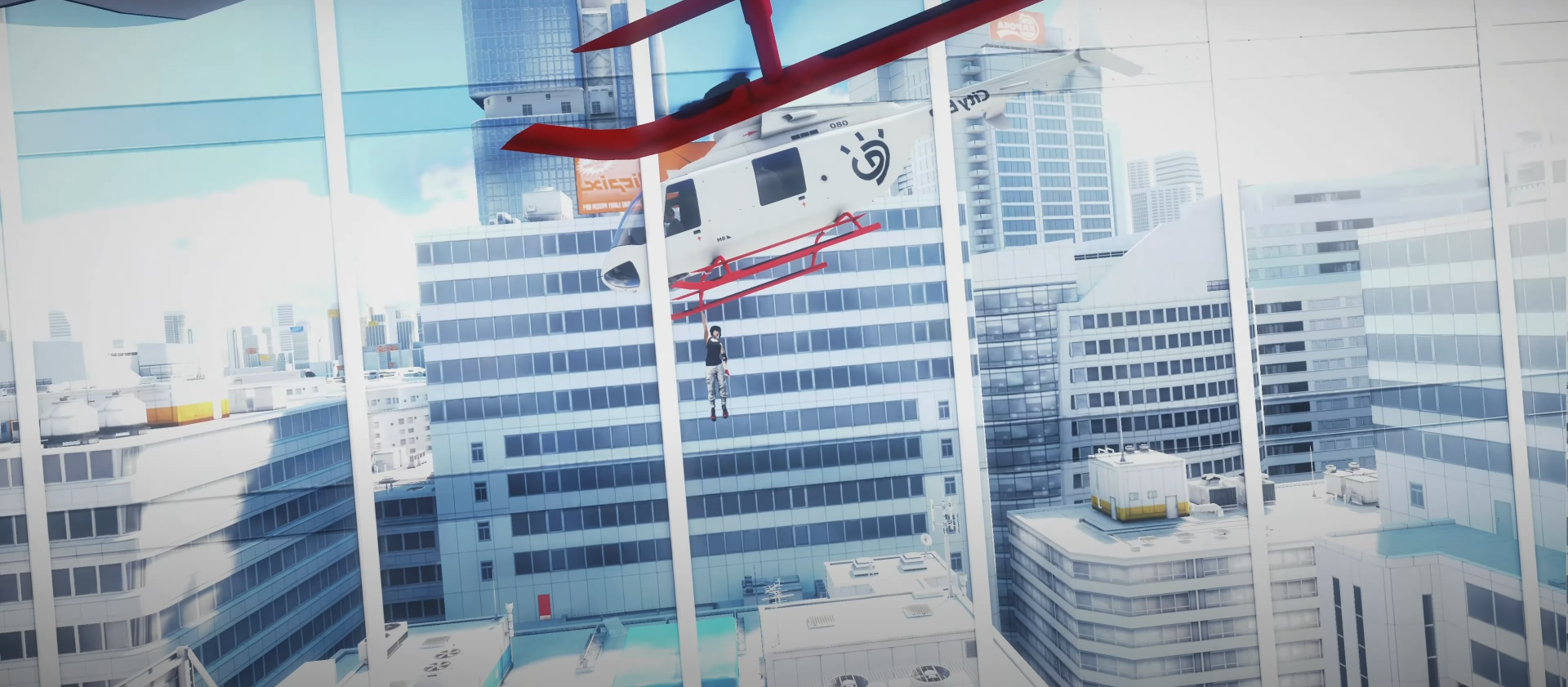
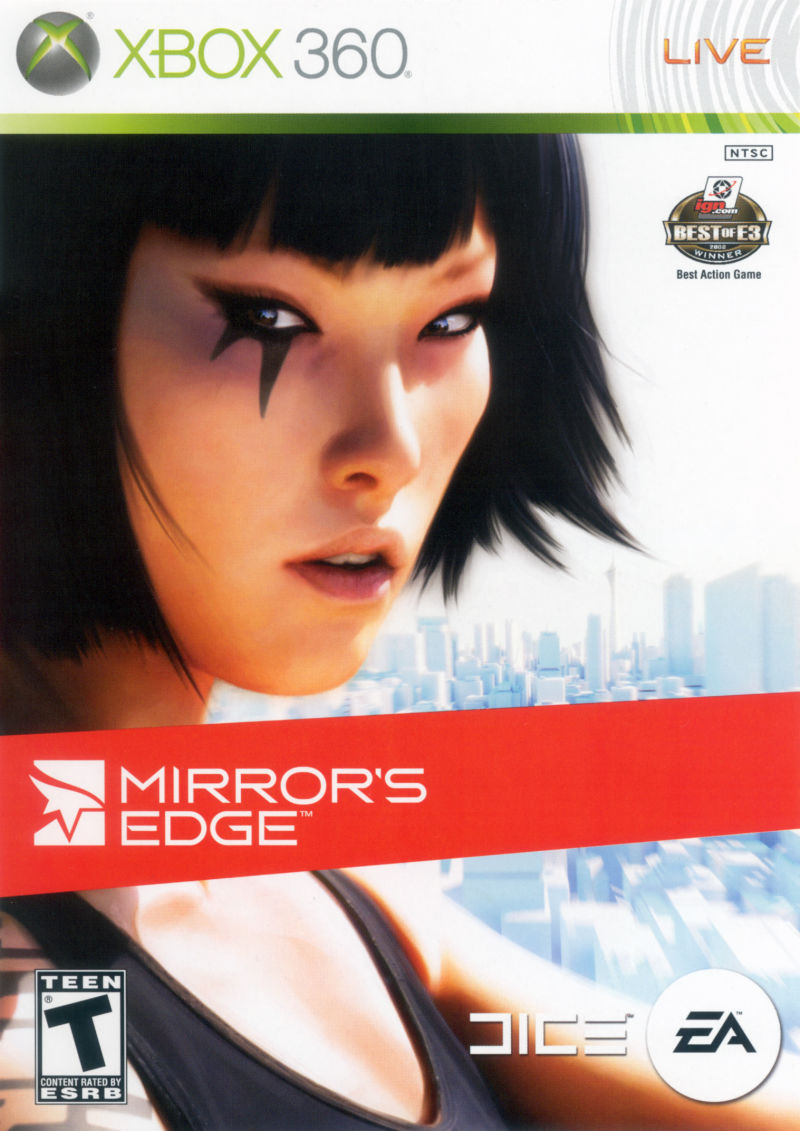
“It’s not news anymore. It’s advertising.”
Mirror’s Edge was groundbreaking at the time of its release, jutting out from the homogenous FPS landscape with a singular platforming experience that emphasized acrobatic navigation over gun-based combat. Featuring unique, immersive gameplay that rewards familiarity, it is the kind of game in which a player can lose themselves for hours on end, easily forgetting that they are a living, breathing human being who needs to eat and drink and sleep and pee, not an insurgent freerunner in a dystopian city jumping between highrise rooftops and dodging machine gun fire.
The game’s first trailer featured a note at the beginning: “The following is all in-game footage.” Meaning, of course, that it wasn’t one of those made-for-television CGI short films that are typically offered as trailers. Instead, this was real footage captured while a player was actually manning the sticks. This distinction is important because in just a few short minutes, the player has leapt between buildings, somersaulted to break their fall, traversed across AC ducts, pipes, and ziplines. They’ve disarmed guards with a variety of techniques, spanned a gap by running along a wall, and dove off skyscraper scaffolding only to spin around in mid-air to shoot back at their pursuer while falling. Most of these maneuvers were old hat for third-person platforming games, but for a genre that hadn’t advanced very far beyond running and jumping, suddenly being granted the ability to run along walls and flip and slide and grab ledges and climb and dropkick was a monumental shift. Heck, even seeing the player-character’s lower limbs wasn’t very common at the time.
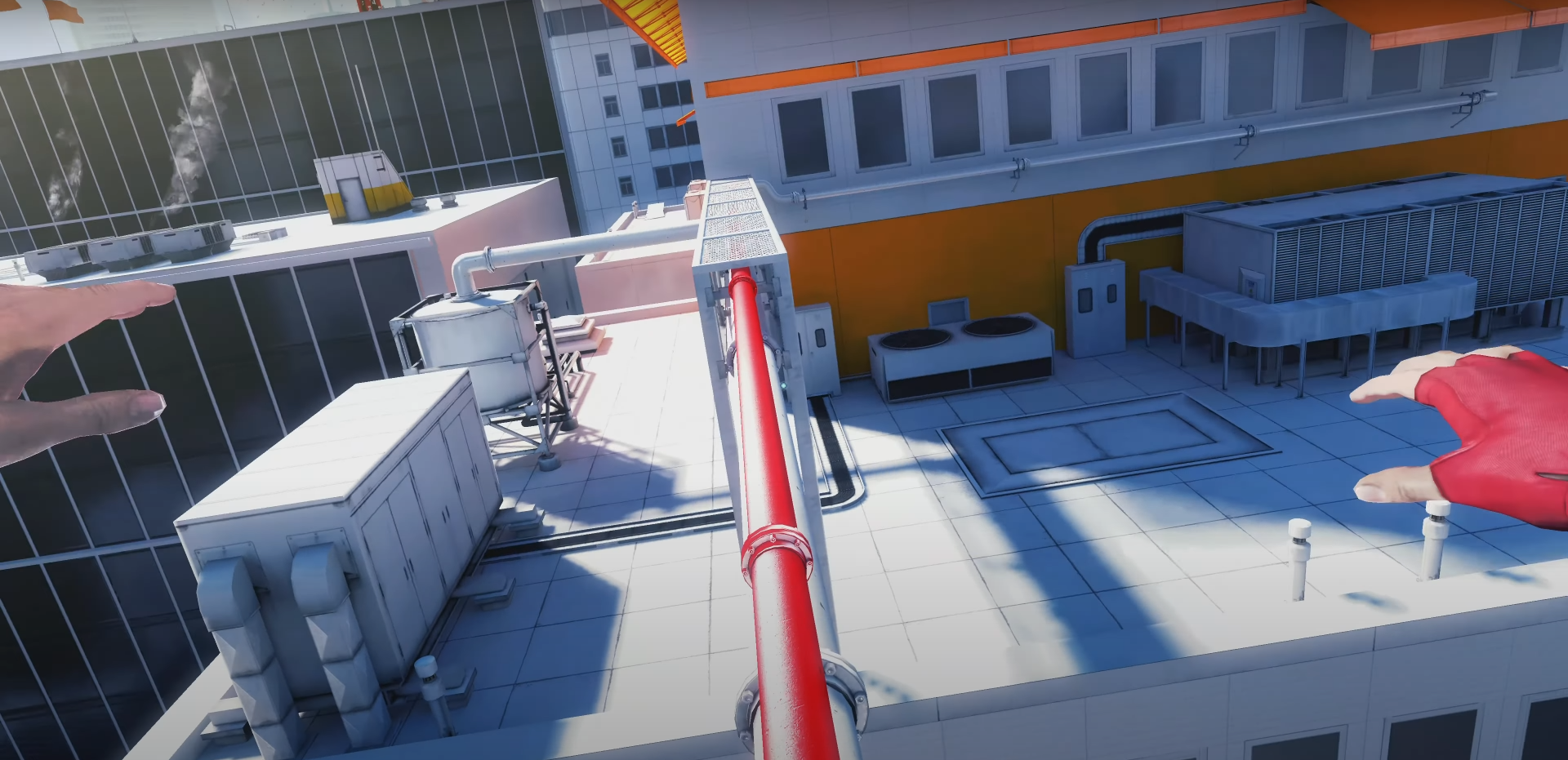
With evasion as the primary technique for dealing with enemies, using weapons is entirely optional, and an adept player can avoid them in all but the most troublesome sections. Indeed, the game so heavily favors its first-person parkour gameplay that one can complete the entire thing without taking a single shot at an enemy. Now, sure, if one wishes to approach the game like a conventional shooter with some tacked-on platforming elements, there’s nothing stopping them. But to do so would be a regrettable mistake because using the standard FPS playstyle in Mirror’s Edge will result in a tedious experience that completely misses the euphoric flow state that the game has in store for the player willing to learn its nuances. There’s certainly a learning curve, but if a player commits to building up a small repertoire of new skills and tuning their reflexes to the game’s scheme, the singular gameplay of Mirror’s Edge will soon begin to feel natural, the player’s movements will become fluid, and they will find themselves traversing levels with speed and dexterity. It is at this point that the game truly blossoms and fulfills its majestic potential as an immersive freerunning experience.
Almost everyone who’s played it agrees that the first-person platforming mechanics of Mirror’s Edge are incredible. Its gameplay is so refreshing and original that one must look outside of the gaming industry for its antecedents. It was most notably inspired by the Jason Bourne films and the chase sequence from Casino Royale. However, unlike an action film or a third-person platforming game, Mirror’s Edge puts you in the shoes of the player-character by framing the action from a first-person perspective. Of course, this is exactly what first-person shooter games had been doing for years. But now, instead of performing actions you’d never do in real life (at least I’ve never 360 no-scoped someone IRL), you’re running and jumping and climbing—natural movements that intuitively connect the player with their virtual avatar, the freerunning courier Faith Connors. Faith’s legs become your legs, her arms your arms, her eyes your eyes. And once you’re properly acquainted with the controls, her acrobatic maneuvers become your acrobatic maneuvers. You may find yourself physically ducking as you move under obstacles, dodging to and fro in your living room, and slightly overheated when you finally put the controller down.
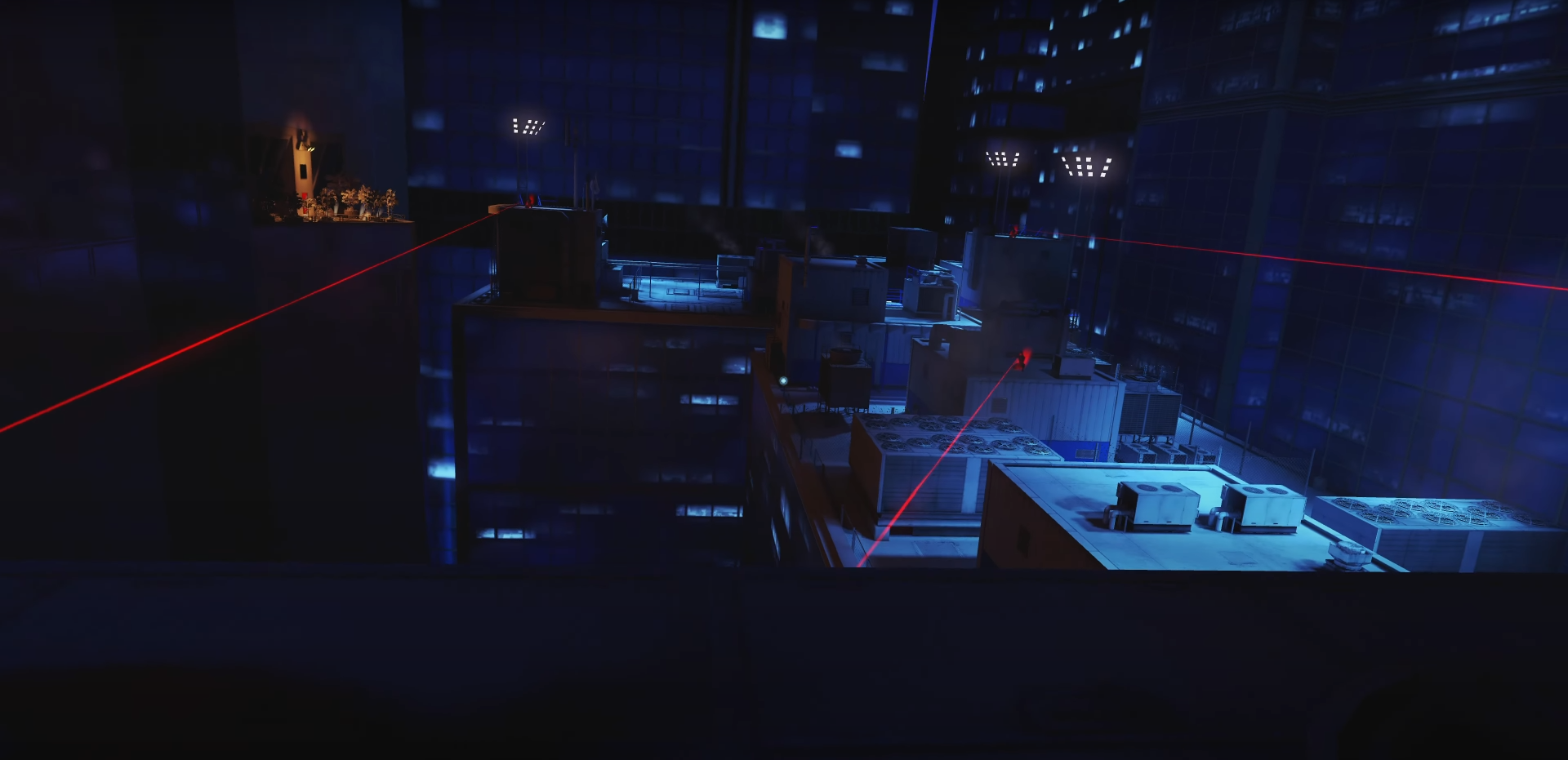
While this immersive quality is uniformly praised, numerous critics lambasted the game for its weak story, plain aesthetics, lack of interaction, reliance on trial and error, and minimal variation. Still others’ complaints essentially boil down to frustration over their own lack of fine motor skills. In other words, the claim is that Mirror’s Edge is an impressive tech demo with a sloppy game jury-rigged atop it without much thought. While such complaints are mostly legitimate, in my estimation the highlighted issues do not detract from the game in an appreciable way.
The story is serviceable but entirely forgettable. The game is set in a future dystopian city where the movements and communications of the general population are regulated by an oppressive regime. To circumnavigate these restrictions, insurgents hire out the dissemination of sensitive information and private goods to a group of underground couriers. Physically carrying clandestine messages while gracefully navigating rooftops, alleys, sewers, and subways, the runners are the connective tissue of the revolution. The player assumes the role of Faith Connors, a skillful young runner who has just begun to operate with some autonomy. But no sooner has the player delivered their first package then Faith becomes entangled in a nasty web of political murders and double crosses that dominates the rest of the narrative. Largely conveyed through a series of interstitial animated cutscenes, the clichéd story never really develops into anything beyond a reason to take a short break from the game every once in a while.
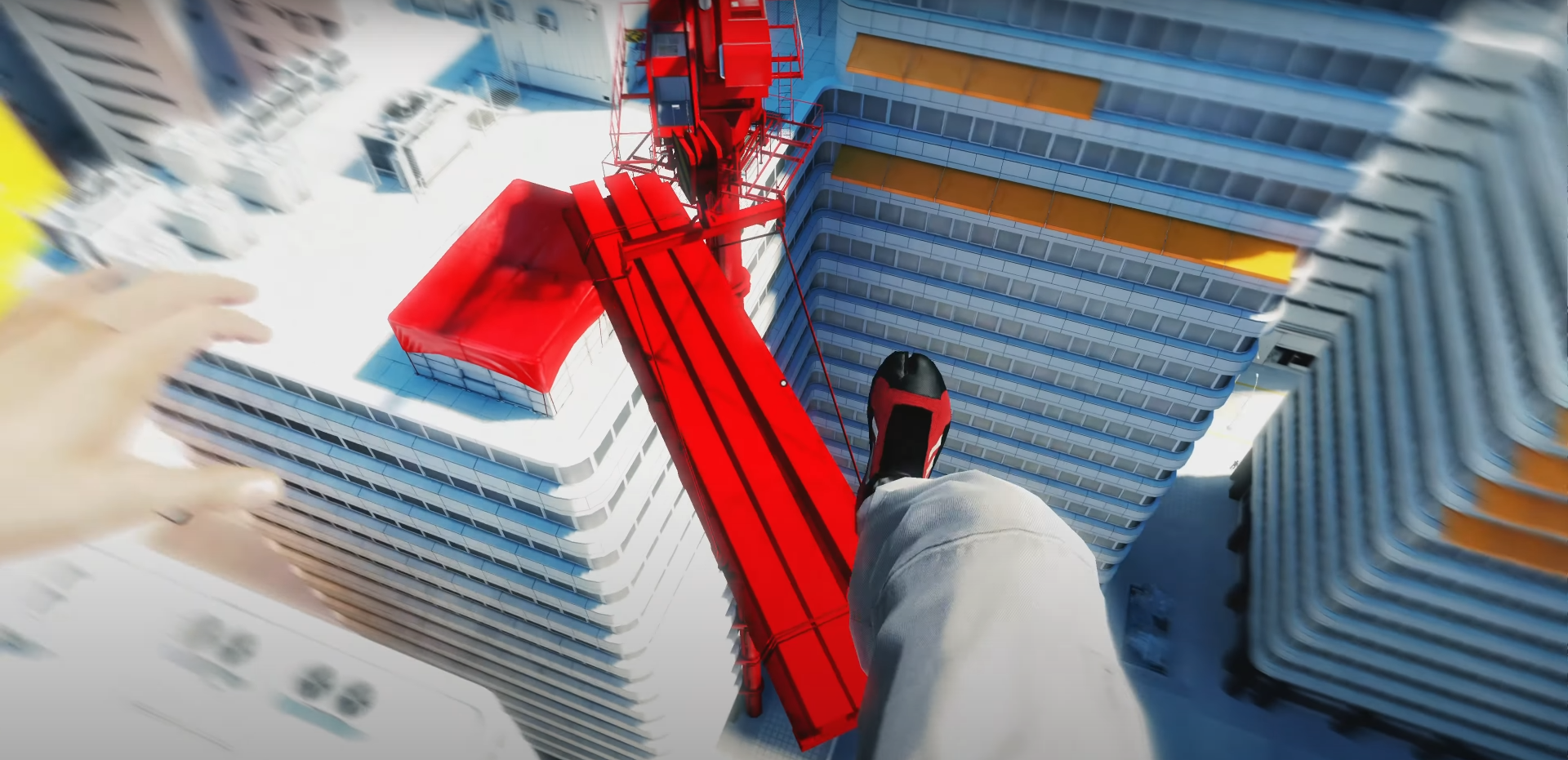
While the animated cutscenes are a nice idea, they are misplaced next to the striking visuals of the actual game—which is funny because usually the opposite is true. Anyway, the aesthetics are a bold choice. Relying on a simple palette of primary and secondary colors, the visuals are crisp and pleasing to the eye; beautiful but harsh, sterile, synthetic, lifeless, just like the magnificent ambient electronica that serves as its score (courtesy of Solar Fields). Entire level sections are often given over to a single dominant color in order to distinguish the various segments. In an era that was angling toward “realism” and all the murky grays and browns that come with the territory, Mirror’s Edge stands out on looks alone. This simplistic color scheme comes in handy on lower difficulties, where the simplest routes from points A to B are highlighted with red, allowing the novice to maintain a decent flow even if they do so inelegantly.
I mentioned earlier that Mirror’s Edge rewards familiarity. What I meant by that is that the game shines its brightest once the player has become intimately familiar with both its controls and its level layouts. Indeed, I have no doubt that even if the designers at Digital Illusions CE had not included a “speed runs” mode, that speedrunning Mirror’s Edge would have caught on anyway. This is the real meat and potatoes of the game, and unfortunately it seems that most never make it that far. Don’t get me wrong, playing through the game for the first time provides an exhilarating experience in its own right. But it’s often frustrating because you’re trying to figure out where to go while bullets whiz past your face. On that first playthrough, and probably the second through sixth, you’ll find yourself mistiming jumps and plummeting a million stories to your death, again and again. Once you’re a veteran, though, there’s something truly special about tackling a large segment of gameplay without a single misstep. Caroming off a wall at just the right angle, timing a jump so that your leading foot can catch the next lip instead of having to slowly climb up with your hands, executing a perfectly-aligned vault that allows you to skip an obstacle—stringing all of these together in a flawless sequence for minutes on end is an intoxicating experience. I’d wager that the critics who cited the game’s linearity and short length as problems never took the time to refine their skills enough to unlock this thrilling style of play for themselves.
Playing Mirror’s Edge a decade after I first encountered it, I feel occasional pangs of nostalgia like I do for any old game that’s had years to percolate in the back of my hippocampus. However, rose-tinted glasses aren’t needed to enjoy it. Far from it, actually. The game may be almost old enough to drive, but it still feels as radical, vivid, and audacious as it did back then. In an era when games require more commitment than the average millennial romance, Mirror’s Edge is a perpetual breath of fresh air, a brisk palate cleanser that never wears out its welcome.